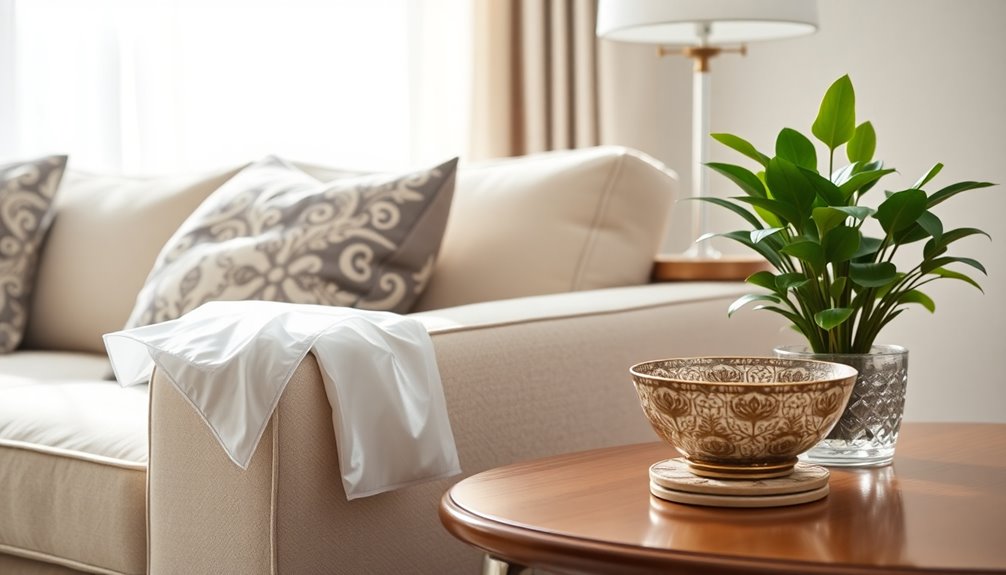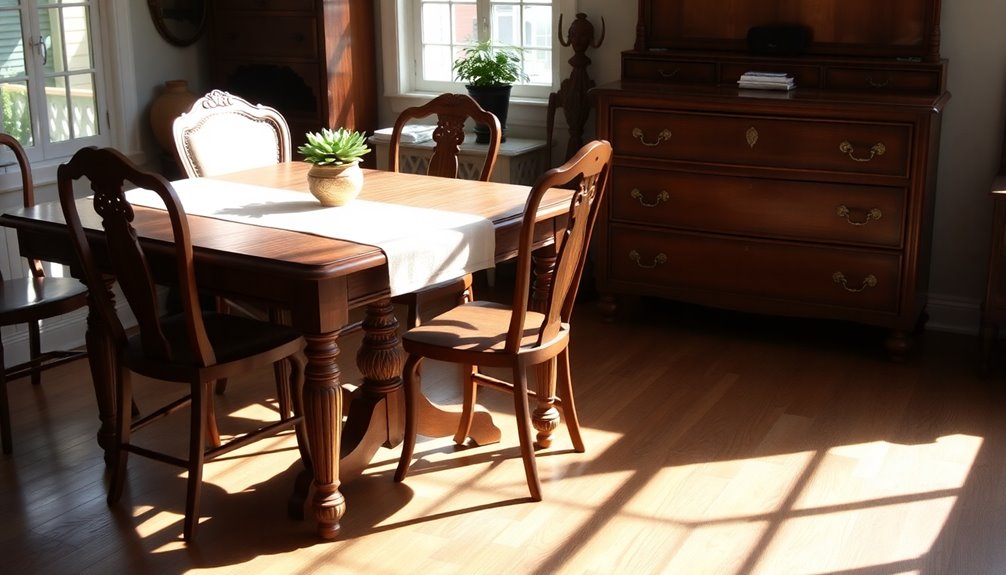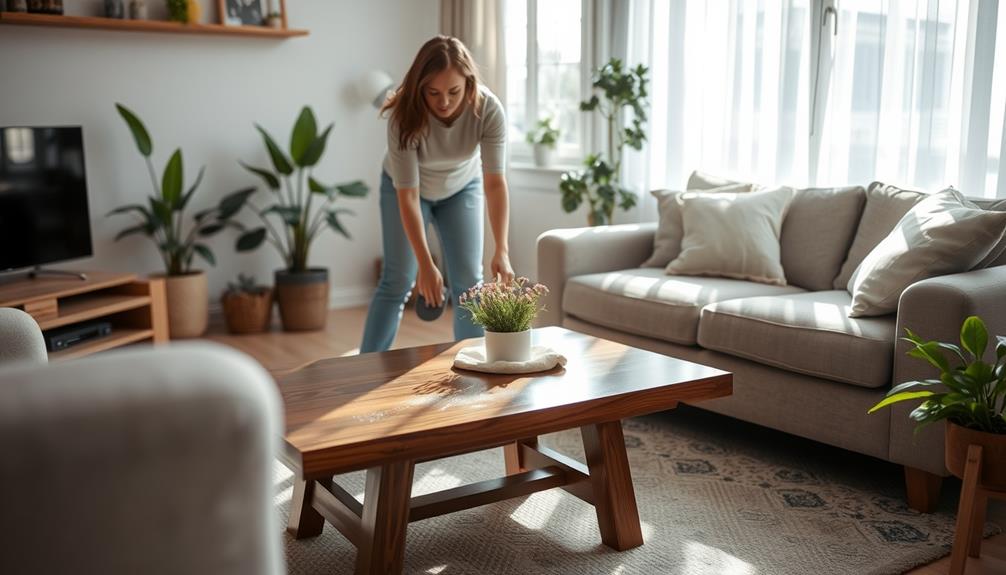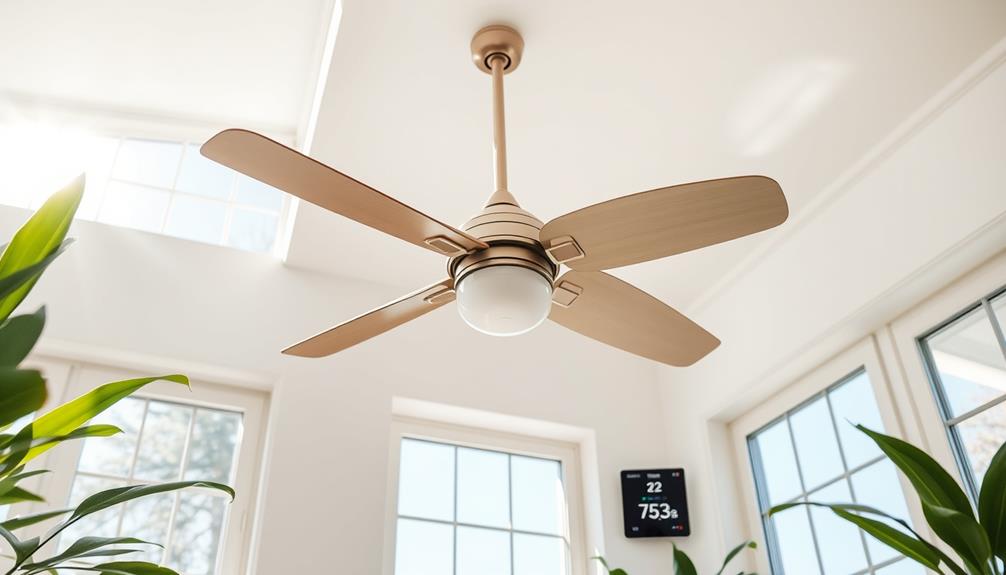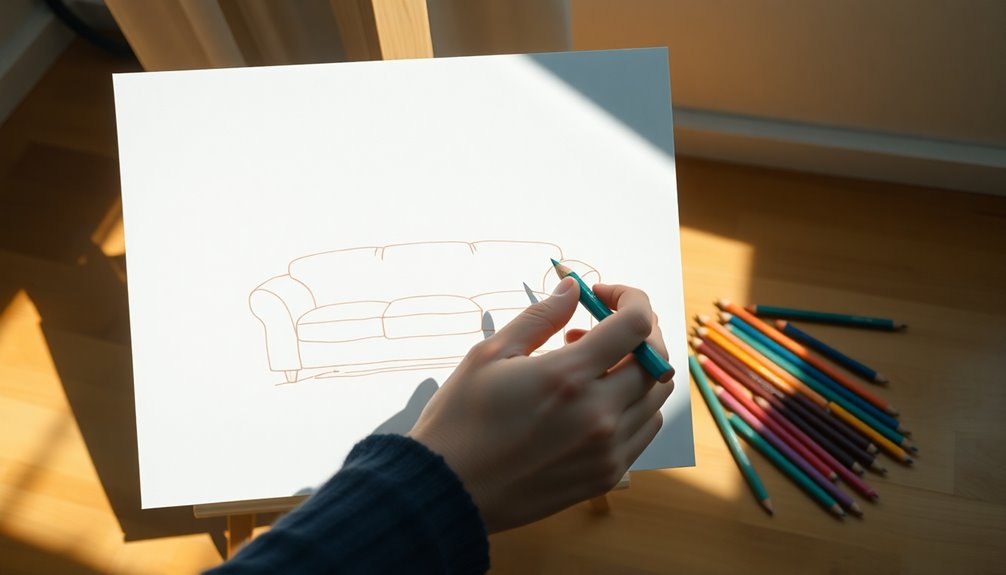To protect your fabric sofa, start by rotating and fluffing the cushions regularly to maintain their shape. Schedule inspections every few months to check for stains or wear. Use fabric-specific cleaners for spills—blot stains quickly and apply the right solutions for different types. Consider treating your sofa with a fabric protector spray every six months to repel liquids and resist stains. Choose durable materials if you have pets and use removable covers for easy washing. Keeping these tips in mind will help your sofa stay beautiful, and you’ll find more strategies for effective care soon. Additionally, it’s important to consider how to choose fabric for sofa based on your lifestyle and aesthetic preferences. Fabrics like microfiber or tightly woven textiles are ideal for households with children or pets, as they tend to be more resistant to wear and tear. By investing time and effort in maintaining your sofa and selecting the right materials, you’ll ensure it remains a beautiful centerpiece in your living space for years to come.
Key Takeaways
- Apply a fabric protector spray every six months to enhance stain resistance and repel liquids on your sofa.
- Regularly vacuum with an upholstery attachment to remove dust, debris, and pet hair, maintaining cleanliness.
- Rotate and fluff cushions frequently to prevent sagging and ensure even wear for prolonged comfort.
- Schedule professional cleaning sessions annually for deep cleaning and maintenance to prolong the life of the fabric.
- Choose durable, pet-friendly materials like microfiber or tightly woven synthetics that withstand wear and tear.
Introduction

To keep your fabric sofa looking its best, regular inspections and targeted cleaning techniques are essential. You'll want to pay special attention to common culprits like wine and coffee spills, as they can be particularly tricky to tackle. By scheduling maintenance and using the right methods, you can protect your investment and extend its lifespan.
Scheduled Upholstery Inspections
Regularly inspecting your fabric sofa is essential for maintaining its appearance and longevity. Schedule inspections at least every six months to assess the condition of your upholstery. During these inspections, look for stains, fraying, or fading; addressing these issues early can prevent further deterioration and keep your sofa looking fresh.
Make it a habit to rotate cushions during your inspections. This simple act helps ensure even wear and prolongs the life of the fabric upholstery by preventing sagging in high-traffic areas. Additionally, use a vacuum with an upholstery attachment to remove dust and debris. This step is crucial for regular maintenance and protects the fabric from dirt buildup.
If you notice deep-set stains or significant wear, consider enlisting professional cleaning services during your scheduled inspections. They can provide thorough care and effectively reapply fabric protectors, enhancing your sofa's resilience against future stains and damage. By committing to these scheduled inspections and cleaning methods, you'll preserve your fabric sofa's beauty and extend its lifespan.
Fabric-Specific Cleaning Techniques
After keeping your fabric sofa in shape with scheduled inspections, it's time to focus on the specific cleaning techniques that suit its fabric type. Different fabrics require tailored approaches; for instance, cotton and linen need gentler cleaning solutions due to their susceptibility to stains and dirt. Meanwhile, synthetic fabrics like polyester and microfiber can handle more robust cleaning methods.
Always test any cleaning solution on an inconspicuous area first to avoid damage or discoloration. For water-based stains, act quickly by blotting with a clean cloth to absorb moisture. Oil-based stains, however, may need a specialized solvent to lift the stain effectively without spreading it.
Regular maintenance plays a crucial role in preserving your sofa. Use a vacuum with an upholstery attachment to remove dirt and dust, and don't forget to use a lint roller for pesky pet hair. Additionally, applying a fabric protector spray every six months can significantly enhance stain resistance, making future cleaning easier and protecting against spills. By following these fabric-specific cleaning techniques, you'll keep your sofa looking fresh and extend its lifespan.
Targeting Wine and Coffee Spills
Wine and coffee spills can be a fabric sofa's worst nightmare, often leading to stubborn stains that mar its elegance. To tackle these challenges effectively, it's crucial to act fast. Blot spills immediately to prevent them from setting in. Use a clean white cloth to absorb the liquid; rubbing can spread the stain and push it deeper into the fabric.
For fresh coffee stains, mix mild dish soap with distilled water. Apply this solution gently with a cloth, then blot to absorb excess moisture. If you're dealing with red wine, consider using an enzymatic cleaner like Nature's Miracle, which breaks down the organic matter in the stain.
Regular cleaning and maintenance can make a significant difference. Apply fabric protection products, such as Scotchgard, to create a barrier against future spills. This preventative measure makes it easier to clean up wine and coffee stains before they become permanent.
Regularly Rotate Cushions

To keep your fabric sofa looking and feeling great, make it a habit to regularly rotate the cushions. This simple practice helps distribute wear evenly, preventing sagging and ensuring comfort. Plus, it can significantly reduce the risk of permanent indentations, so your sofa stays inviting for years to come.
Paw-Friendly Fabric Options
Choosing the right fabric for your sofa can make a significant difference when you have pets. Opting for paw-friendly fabric options like microfiber or tightly woven synthetic materials enhances durability and minimizes damage from pet claws. These durable materials can withstand daily wear while keeping your sofa looking fresh.
Regularly rotating cushions is essential, but don't overlook the benefits of removable, washable covers. They allow for easy cleaning, making it simpler to manage pet hair and stains. Fabrics treated with built-in stain resistance, such as Teflon-coated options, can further protect against spills and accidents, ensuring your sofa remains pristine despite your furry friends.
To maintain cleanliness, regular vacuuming and the use of pet hair removers or lint rollers are crucial. This not only keeps your sofa looking great but also reduces allergens in your home, creating a comfortable environment for both you and your pets. By choosing the right fabric and maintaining it properly, you can enjoy your sofa for years to come, all while keeping it safe from the inevitable messes that come with pet ownership.
Seasonal Fabric Cover Changes
Changing your sofa's fabric covers with the seasons can breathe new life into your living space and keep your sofa looking fresh. One effective way to enhance your sofa's longevity is through regular cushion rotation. By rotating your cushions every few weeks, especially in high-traffic areas, you can distribute wear evenly across the fabric, helping to maintain shape and prevent sagging.
Consider using washable slipcovers for your cushions. They make seasonal fabric cover changes a breeze, allowing you to easily clean or switch them out as needed. This simple practice not only simplifies maintenance but also helps minimize permanent stains and dirt buildup, ensuring your sofa stays looking its best.
Incorporating seasonal fabric cover changes can significantly boost the aesthetic appeal of your living room. You can align your sofa's look with seasonal decor, creating a cohesive and inviting atmosphere. Embrace the opportunity to refresh your space while caring for your fabric sofa. With these strategies, you'll enhance both the style and durability of your beloved sofa for years to come.
Cushion Rotation Schedule
Your sofa's comfort and longevity depend significantly on a consistent cushion rotation schedule. Regularly rotating your cushions every few weeks helps ensure even wear and prevents sagging, which extends the lifespan of your upholstered furniture. By changing the positions of the cushions, you minimize the formation of permanent indentations and maintain a uniform appearance in your living room.
Experts recommend a systematic approach to cushion rotation. For instance, move the front cushion to the back and vice versa. This promotes balanced use and keeps all areas of the sofa recovering from pressure, retaining their shape over time. Consistent cushion rotation not only enhances comfort but also helps in preserving the fabric's integrity.
Incorporate cushion rotation into your regular cleaning and maintenance routine for optimal results. By making this simple practice a habit, you're actively protecting your investment and keeping your living space looking great. Remember, a little effort goes a long way in extending the life of your fabric sofa, ensuring it remains a cozy and stylish centerpiece in your home. So, don't overlook this easy task; your sofa will thank you!
Routine Fabric Condition Checks

When you're checking your fabric sofa, don't just focus on the fabric itself; consider the overall frame stability too. You might also want to think about leather repair techniques if your sofa has leather accents. Lastly, make sure to fluff those cushions regularly to keep everything looking and feeling great.
Frame Stability Concerns
How often do you take a moment to check the stability of your fabric sofa's frame? Regular inspection is crucial for maintaining your fabric furniture. Every three to six months, you should perform routine checks to identify any wear signs that could affect the frame stability. Start by looking for loose joints or creaking sounds; these are often early indicators of structural issues.
Next, examine the legs and supports of the sofa. Weak or broken legs can seriously compromise the overall stability of the frame. If you notice any damage, it's important to address it promptly to prevent further problems. Additionally, check the fabric and cushioning. Thinning or sagging can signal underlying frame issues that need attention.
Leather Repair Techniques
To keep your fabric sofa looking its best, routine condition checks are essential. These checks involve inspecting your upholstery for signs of wear, like fraying or discoloration. You should perform these checks at least once a month, especially in high-traffic areas, to catch potential problems early. Look for stains on fabric, dirt accumulation, or loose seams. If you find any issues, take immediate action to treat them, as this is crucial for effective fabric furniture protection.
Regularly rotating cushions and inspecting their condition can help prevent sagging and ensure even wear on the fabric. This practice not only maintains your sofa's appearance but also extends its lifespan. Make sure to document any maintenance or repair work during your checks. Keeping a history of your sofa's care helps inform future cleaning and restoration efforts. Additionally, maintaining good indoor air quality by using air purifiers can help reduce dust and allergens that may accumulate on your fabric sofa.
Cushion Fluffing Techniques
Amid routine fabric condition checks, cushion fluffing plays a vital role in maintaining your sofa's comfort and appearance. To start, make it a habit to fluff and rotate your cushions every few weeks. This simple practice helps prevent uneven wear and allows them to maintain shape, especially in high-traffic areas.
Before you begin fluffing, use a vacuum with an upholstery attachment to remove dust and debris from the cushions. This ensures your maintenance routine is thorough and effective. For foam cushions, gently knead and squeeze them to redistribute the filling, restoring their original shape and enhancing both comfort and aesthetics.
While fluffing, check for any signs of wear, like sagging or lumps. This proactive approach allows you to address issues before they worsen, helping to prolong the life of your fabric furniture. Additionally, consider using removable, washable cushion covers. They protect fabric furniture while making it easier to keep your cushions clean and fluffy. By incorporating these cushion fluffing techniques into your routine, you'll ensure your sofa remains inviting and comfortable for years to come.
Personalized Fabric Treatments
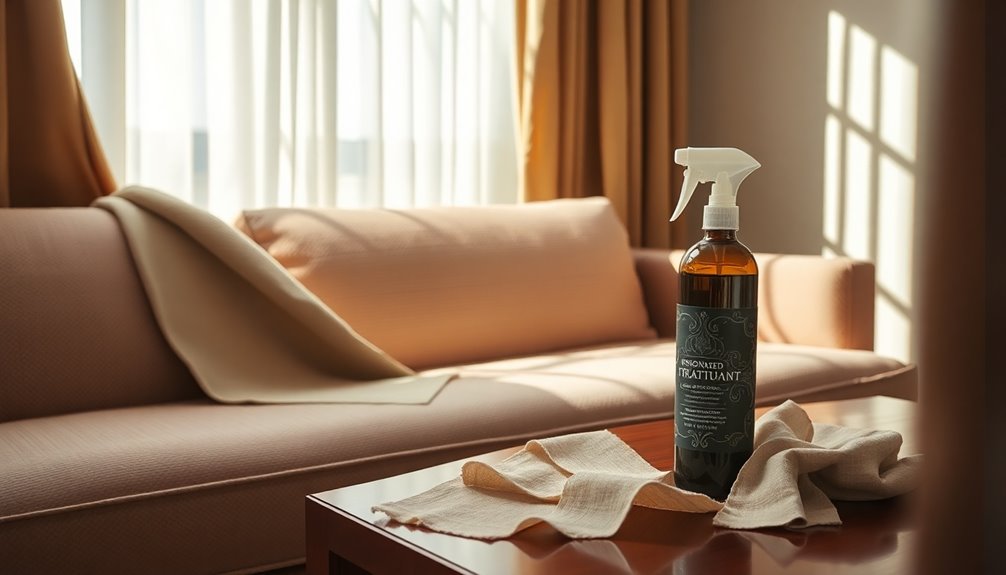
Enhancing your fabric sofa's durability through personalized fabric treatments can significantly improve its resistance to stains and spills. Options like Teflon or Nano Tex finishes create an invisible shield against both water and oil-based stains, giving you peace of mind when it comes to accidental spills. Products like Ultra Guard offer a clear polymer treatment that's non-toxic and eco-friendly, providing permanent stain protection against spills and mold while preventing UV fade.
If you're looking for immediate protection, consider hiring professional services that can apply fabric protectors on-site before your upholstery arrives. This ensures your sofa is ready to withstand everyday challenges right from the start. For a more budget-friendly approach, DIY solutions like Ultra Guard's Stain-Free spray can effectively cover an 8-foot sofa, offering a cost-effective way to enhance stain resistance.
While performance fabrics like Crypton provide improved stain resistance, remember they're not entirely stain-proof. This highlights the importance of incorporating personalized treatments to maximize your sofa's longevity and maintain its appearance. With these strategies, you can enjoy your fabric sofa without the worry of stains ruining its beauty.
Ongoing Fabric Maintenance Strategies
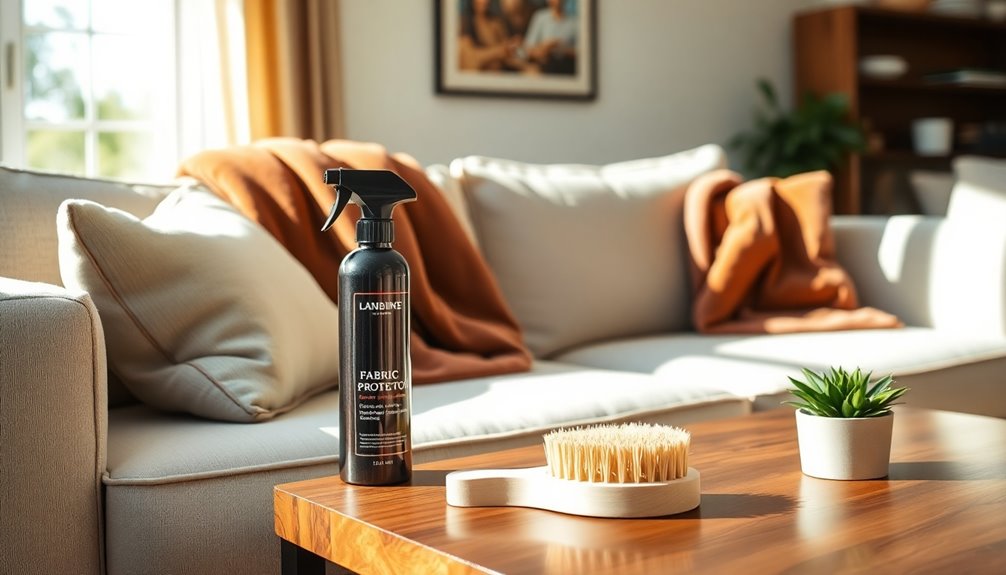
Regular upkeep is key to keeping your fabric sofa looking fresh and lasting longer. Start with regular vacuuming using an upholstery attachment; aim to do this weekly to monthly, depending on how much you use your sofa. This helps remove dust and debris that can wear down the fabric over time.
When spills occur, act quickly by blotting them with a clean, dry cloth. Immediate action significantly increases your chances of effective stain removal. To further protect your sofa, apply a fabric protector every six months; this creates a barrier that repels liquids and reduces how often you need to clean.
Don't forget about cushion rotation! Regularly rotating your cushions promotes even wear and prevents sagging, which keeps your sofa comfortable and looking good. Additionally, schedule professional cleaning sessions once or twice a year. This deep cleaning tackles tougher stains and maintains both the appearance and structure of your sofa. By following these ongoing maintenance strategies, you'll ensure your fabric sofa remains a beautiful and functional centerpiece in your home for years to come.
Conclusion

Maintaining your fabric sofa with ongoing care has a significant impact on its longevity and appearance. By regularly applying fabric protectors like Scotchgard or eco-friendly alternatives, you can shield your sofa from water, oil, and stains. This proactive approach helps you remove dirt and pet stains before they set in.
Consider using removable and washable slipcovers, especially if you have kids or pets. They serve as an extra barrier against spills and general wear and tear. When accidents happen, act quickly—blot spills with a clean, dry cloth to increase your chances of successful stain removal.
Don't forget to vacuum your sofa weekly with a HEPA filter vacuum. This routine helps eliminate dust, allergens, and pet hair, keeping your sofa looking fresh and clean. Additionally, think about scheduling professional cleaning services at least once a year. This ensures deep-set stains are addressed, and fabric protectors are reapplied, maintaining your sofa's condition over time. Regular grooming of your pets can also significantly reduce excess fur shedding, making it easier to keep your sofa clean and fur-free.
Frequently Asked Questions
Can You Protect a Fabric Sofa?
Yes, you can definitely protect a fabric sofa. You can apply fabric protector sprays to create a barrier against stains and spills. It's a good idea to reapply these every six months. Using removable slipcovers also helps, especially if you've got kids or pets. Regularly vacuuming your sofa with an upholstery attachment keeps it clean, and immediately blotting spills can prevent stains from setting in. Taking these steps will keep your sofa looking great!
Does Scotchgard Really Work on Sofas?
Does Scotchgard really work on sofas? Yes, it's known for providing reliable stain protection, making it a popular choice among many. You can easily apply it to delicate fabrics like silk or wool from a distance of six inches. Just remember to test it on a hidden area first. Regular reapplication every six months helps maintain its effectiveness, although some stubborn stains might still need extra treatment despite Scotchgard's protective barrier.
How Do You Maintain a Fabric Sofa?
To maintain your fabric sofa, start by vacuuming it weekly with an upholstery attachment to keep dust and dirt at bay. When spills happen, blot them immediately with a clean, dry cloth to maximize stain removal chances. Rotate the cushions regularly to ensure even wear and prevent sagging. Every six months, consider applying a fabric protector spray, and don't forget to schedule professional cleanings once or twice a year for deeper maintenance.
How Long Does Scotchgard Last on a Sofa?
Scotchgard typically lasts about 6 months to a year on your sofa, depending on how much you use it and environmental factors like humidity and sunlight. To keep it effective, you should reapply Scotchgard every 6 months, especially in high-traffic areas or if you have pets and kids. Just remember, avoid saturating the fabric during application, and always test it on a hidden spot first to ensure compatibility.
